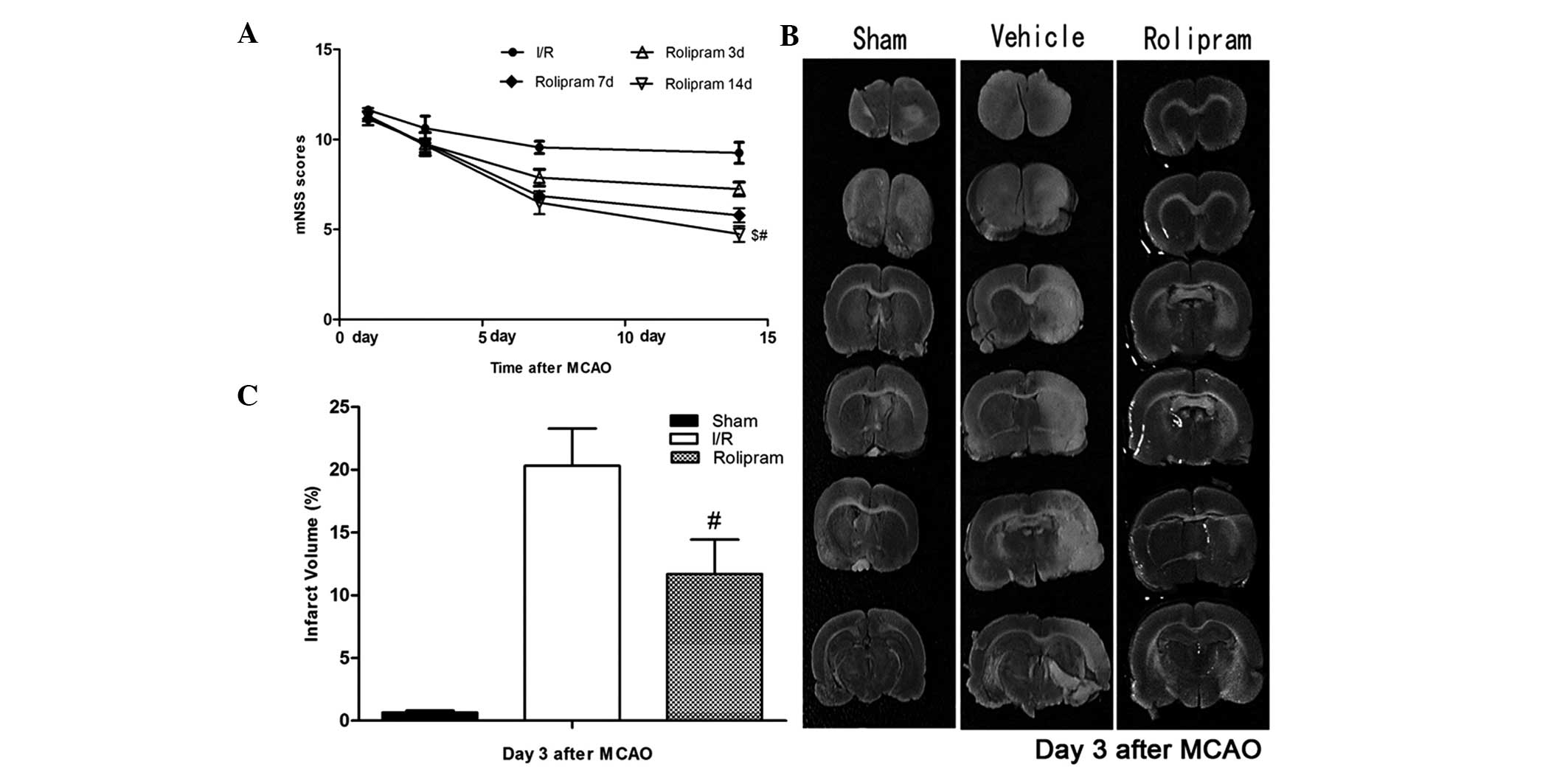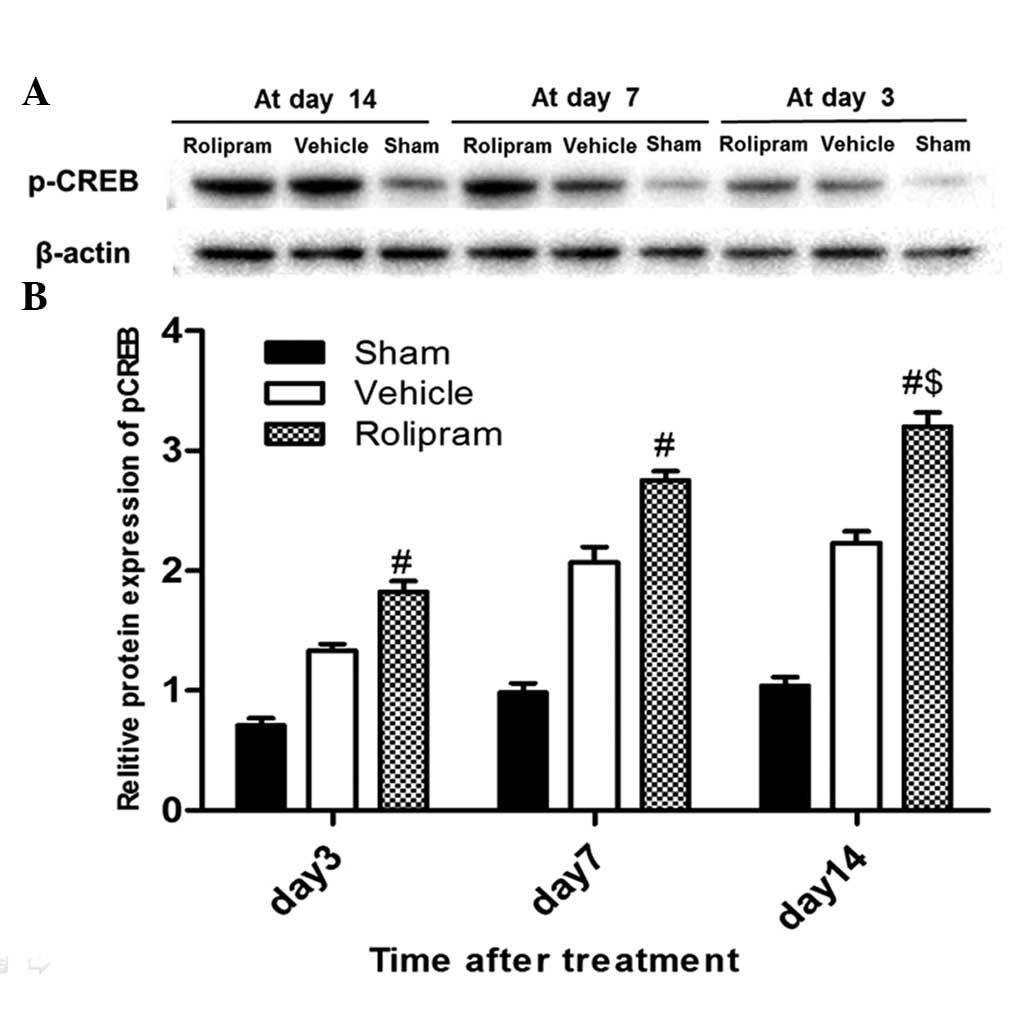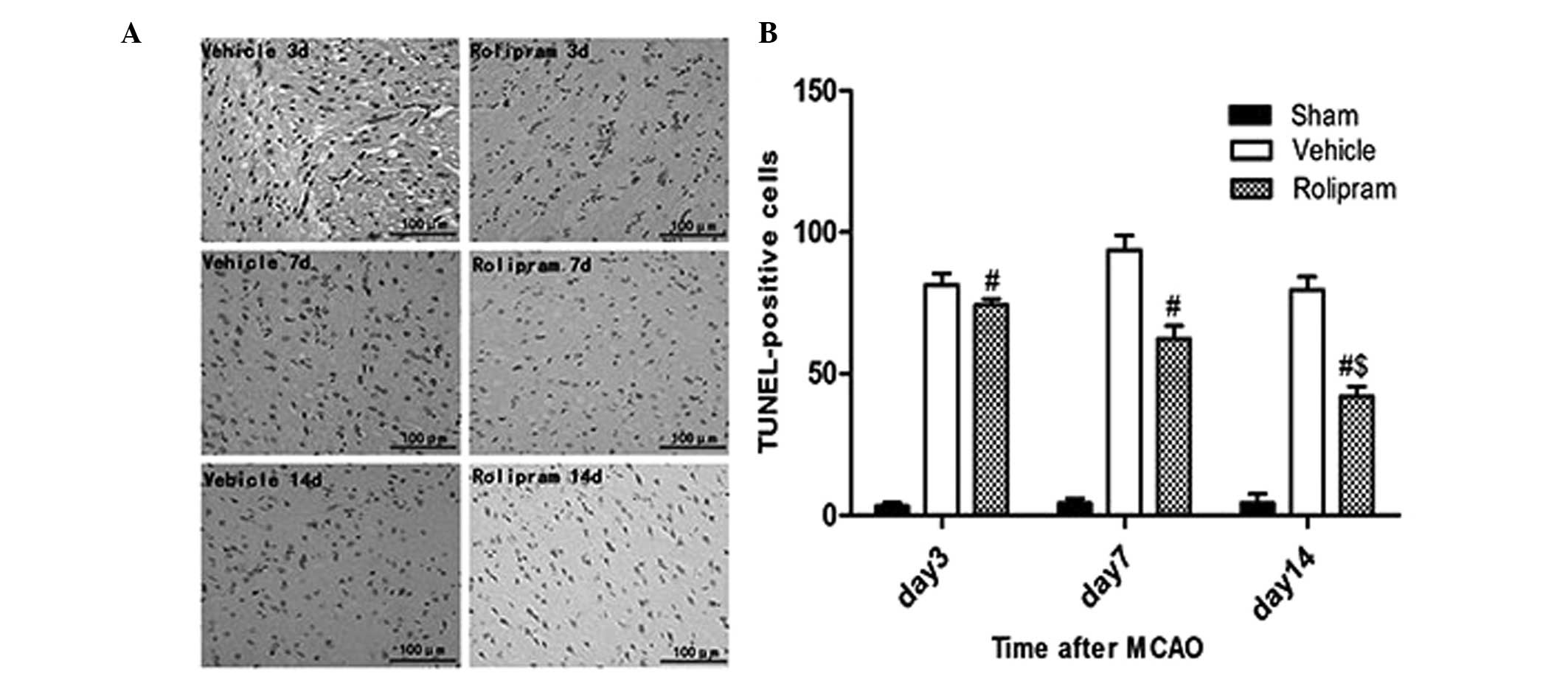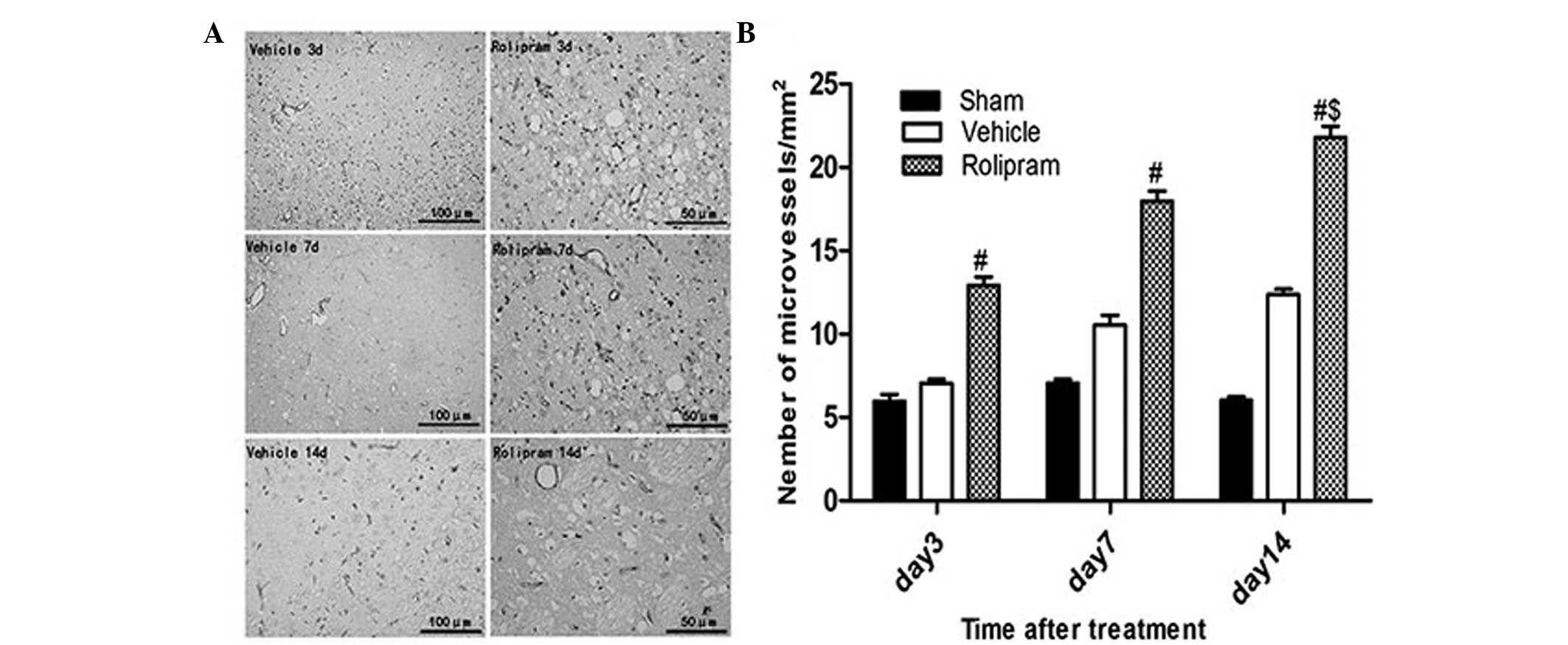|
1
|
Lee YS, Chio CC, Chang CP, et al: Long
course hyperbaric oxygen stimulates neurogenesis and attenuates
inflammation after ischemic stroke. Mediators Inflamm.
2013:5129782013. View Article : Google Scholar : PubMed/NCBI
|
|
2
|
Okuyama S, Shimada N, Kaji M, et al:
Heptamethoxyflavone, a citrus flavonoid, enhances brain-derived
neurotrophic factor production and neurogenesis in the hippocampus
following cerebral global ischemia in mice. Neurosci Lett.
528:190–195. 2012. View Article : Google Scholar : PubMed/NCBI
|
|
3
|
Yang J, Shi QD, Song TB, et al: Vasoactive
intestinal peptide increases VEGF expression to promote
proliferation of brain vascular endothelial cells via the cAMP/PKA
pathway after ischemic insult in vitro. Peptides. 42:105–111. 2013.
View Article : Google Scholar : PubMed/NCBI
|
|
4
|
Genovese TI, Mazzon E, Paterniti I,
Esposito E and Cuzzocrea S: Neuroprotective effects of olprinone
after cerebral ischemia/reperfusion injury in rats. Neurosci Lett.
503:93–99. 2011. View Article : Google Scholar : PubMed/NCBI
|
|
5
|
Shu L, Li T, Han S, et al: Inhibition of
neuron-specific CREB dephosphorylation is involved in propofol and
ketamine-induced neuroprotection against cerebral ischemic injuries
of mice. Neurochem Res. 37:49–58. 2012. View Article : Google Scholar : PubMed/NCBI
|
|
6
|
Bourtchuladze R, Frenguelli B, Blendy J,
et al: Deficient long-term memory in mice with a targeted mutation
of the cAMP-responsive element-binding protein. Cell. 79:59–68.
1994. View Article : Google Scholar : PubMed/NCBI
|
|
7
|
Josselyn SA, Shi C, Carlezon WA Jr, Neve
RL, Nestler EJ and Davis M: Long-term memory is facilitated by cAMP
response element-binding protein overexpression in the amygdala. J
Neurosci. 21:2404–2412. 2001.PubMed/NCBI
|
|
8
|
Yamashima T: ‘PUFA-GPR40-CREB signaling’
hypothesis for the adult primate neurogenesis. Prog Lipid Res.
51:221–231. 2012. View Article : Google Scholar : PubMed/NCBI
|
|
9
|
Carlezon WA Jr, Duman RS and Nestler EJ:
The many faces of CREB. Trends Neurosci. 28:436–445. 2005.
View Article : Google Scholar : PubMed/NCBI
|
|
10
|
Merz K, Herold S and Lie DC: CREB in adult
neurogenesis - master and partner in the development of adult-born
neurons? Eur J Neurosci. 33:1078–1086. 2011. View Article : Google Scholar : PubMed/NCBI
|
|
11
|
Wei Z, Belal C, Tu W, et al: Chronic
nicotine administration impairs activation of cyclic AMP-response
element binding protein and survival of newborn cells in the
dentate gyrus. Stem Cells Dev. 21:411–422. 2012. View Article : Google Scholar : PubMed/NCBI
|
|
12
|
Chava KR, Tauseef M, Sharma T and Mehta D:
Cyclic AMP response element-binding protein prevents endothelial
permeability increase through transcriptional controlling
p190RhoGAP expression. Blood. 119:308–319. 2012. View Article : Google Scholar : PubMed/NCBI
|
|
13
|
Ma W, Zheng WH, Powell K, Jhamandas K and
Quirion R: Chronic morphine exposure increases the phosphorylation
of MAP kinases and the transcription factor CREB in dorsal root
ganglion neurons: an in vitro and in vivo study. Eur J Neurosci.
14:1091–1104. 2001. View Article : Google Scholar : PubMed/NCBI
|
|
14
|
Li LX, Cheng YF, Lin HB, Wang C, Xu JP and
Zhang HT: Prevention of cerebral ischemia-induced memory deficits
by inhibition of phosphodiesterase-4 in rats. Metab Brain Dis.
26:37–47. 2011. View Article : Google Scholar : PubMed/NCBI
|
|
15
|
Li YF, Huang Y, Amsdell SL, Xiao L,
O'Donnell JM and Zhang HT: Antidepressant- and anxiolytic-like
effects of the phosphodiesterase-4 inhibitor rolipram on behavior
depend on cyclic AMP response element binding protein-mediated
neurogenesis in the hippocampus. Neuropsychopharmacology.
34:2404–2419. 2009. View Article : Google Scholar : PubMed/NCBI
|
|
16
|
Li YF, Cheng YF, Huang Y, et al:
Phosphodiesterase-4D knock-out and RNA interference-mediated
knock-down enhance memory and increase hippocampal neurogenesis via
increased cAMP signaling. J Neurosci. 31:172–183. 2011. View Article : Google Scholar : PubMed/NCBI
|
|
17
|
Chen C, Hu Q, Yan J, et al: Multiple
effects of 2ME2 and D609 on the cortical expression of HIF-1alpha
and apoptotic genes in a middle cerebral artery occlusion-induced
focal ischemia rat model. J Neurochem. 102:1831–1841. 2007.
View Article : Google Scholar : PubMed/NCBI
|
|
18
|
Sasaki T, Kitagawa K, Omura-Matsuoka E, et
al: The phosphodiesterase inhibitor rolipram promotes survival of
newborn hippocampal neurons after ischemia. Stroke. 38:1597–1605.
2007. View Article : Google Scholar : PubMed/NCBI
|
|
19
|
Shu L, Li T, Han S, Ji F, Pan C, Zhang B
and Li J: Inhibition of neuron-specific CREB dephosphorylation is
involved in propofol and ketamine-induced neuroprotection against
cerebral ischemic injuries of mice. Neurochem Res. 37:49–58. 2012.
View Article : Google Scholar : PubMed/NCBI
|
|
20
|
Boneva NB and Yamashima T: New insights
into ‘GPR40-CREB interaction in adult neurogenesis’ specific for
primates. Hippocampus. 22:896–905. 2012. View Article : Google Scholar : PubMed/NCBI
|
|
21
|
Lonze BE and Ginty DD: Function and
regulation of CREB family transcription factors in the nervous
system. Neuron. 35:605–623. 2002. View Article : Google Scholar : PubMed/NCBI
|
|
22
|
Ji Y, Lu Y, Yang F, et al: Acute and
gradual increases in BDNF concentration elicit distinct signaling
and functions in neurons. Nat Neurosci. 13:302–309. 2010.
View Article : Google Scholar : PubMed/NCBI
|
|
23
|
Jagasia R, Steib K, Englberger E, et al:
GABA-cAMP response element-binding protein signaling regulates
maturation and survival of newly generated neurons in the adult
hippocampus. J Neurosci. 29:7966–7977. 2009. View Article : Google Scholar : PubMed/NCBI
|
|
24
|
Herold S, Jagasia R, Merz K, Wassmer K and
Lie DC: CREB signalling regulates early survival, neuronal gene
expression and morphological development in adult subventricular
zone neurogenesis. Mol Cell Neurosci. 46:79–88. 2011. View Article : Google Scholar : PubMed/NCBI
|
|
25
|
Johannessen M, Delghandi MP and Moens U:
What turns CREB on? Cell Signal. 16:1211–1227. 2004. View Article : Google Scholar : PubMed/NCBI
|
|
26
|
Nair A and Vaidya VA: Cyclic AMP response
element binding protein and brain-derived neurotrophic factor:
molecules that modulate our mood? J Biosci. 31:423–434. 2006.
View Article : Google Scholar : PubMed/NCBI
|
|
27
|
Barros DM, Izquierdo LA, Sant'Anna MK, et
al: Stimulators of the cAMP cascade reverse amnesia induced by
intra-amygdala but not intrahippocampal KN-62 administration.
Neurobiol Learn Mem. 71:94–103. 1999. View Article : Google Scholar : PubMed/NCBI
|
|
28
|
Min D, Mao X, Wu K, et al: Donepezil
attenuates hippocampal neuronal damage and cognitive deficits after
global cerebral ischemia in gerbils. Neurosci Lett. 510:29–33.
2012. View Article : Google Scholar : PubMed/NCBI
|
|
29
|
Shin JA, Lee KE, Kim HS and Park EM: Acute
resveratrol treatment modulates multiple signaling pathways in the
ischemic brain. Neurochem Res. 37:2686–2696. 2012. View Article : Google Scholar : PubMed/NCBI
|
|
30
|
Mu J, Ostrowski RP, Soejima Y, et al:
Delayed hyperbaric oxygen therapy induces cell proliferation
through stabilization of cAMP responsive element binding protein in
the rat model of MCAo-induced ischemic brain injury. Neurobiol Dis.
51:133–143. 2013. View Article : Google Scholar : PubMed/NCBI
|
|
31
|
Zhang HT: Cyclic AMP-specific
phosphodiesterase-4 as a target for the development of
antidepressant drugs. Curr Pharm Des. 15:1688–1698. 2009.
View Article : Google Scholar : PubMed/NCBI
|
|
32
|
Zhang HT: Phosphodiesterase targets for
cognitive dysfunction and schizophrenia - a New York Academy of
Sciences meeting. IDrugs. 13:166–168. 2010.PubMed/NCBI
|
|
33
|
Kao CH, Chen SH, Chio CC and Lin MT: Human
umbilical cord blood-derived CD34+ cells may attenuate
spinal cord injury by stimulating vascular endothelial and
neurotrophic factors. Shock. 29:49–55. 2008.PubMed/NCBI
|
|
34
|
Li S, Wei M, Zhou Z, Wang B, Zhao X and
Zhang J: SDF-1α induces angiogenesis after traumatic brain injury.
Brain Res. 1444:76–86. 2012. View Article : Google Scholar : PubMed/NCBI
|
|
35
|
Krupinski JI, Kaluza J, Kumar P, Kumar S
and Wang JM: Role of angiogenesis in patients with cerebral
ischemic stroke. Stroke. 25:1794–1798. 1994. View Article : Google Scholar : PubMed/NCBI
|
|
36
|
Yang J, Shi QD, Song TB, Feng GF, Zang WJ,
Zong CH and Chang L: Vasoactive intestinal peptide increases VEGF
expression to promote proliferation of brain vascular endothelial
cells via the cAMP/PKA pathway after ischemic insult in vitro.
Peptides. 42:105–111. 2013. View Article : Google Scholar : PubMed/NCBI
|
|
37
|
Baugh JA, Gantier M, Li L, Byrne A,
Buckley A and Donnelly SC: Dual regulation of macrophage migration
inhibitory factor (MIF) expression in hypoxia by CREB and HIF-1.
Biochem Biophys Res Commun. 347:895–903. 2006. View Article : Google Scholar : PubMed/NCBI
|
|
38
|
Leung KW, Ng HM, Tang MK, Wong CC, Wong RN
and Wong AS: Ginsenoside-Rg1 mediates a hypoxia-independent
upregulation of hypoxia-inducible factor-1α to promote
angiogenesis. Angiogenesis. 14:515–522. 2011. View Article : Google Scholar : PubMed/NCBI
|


















